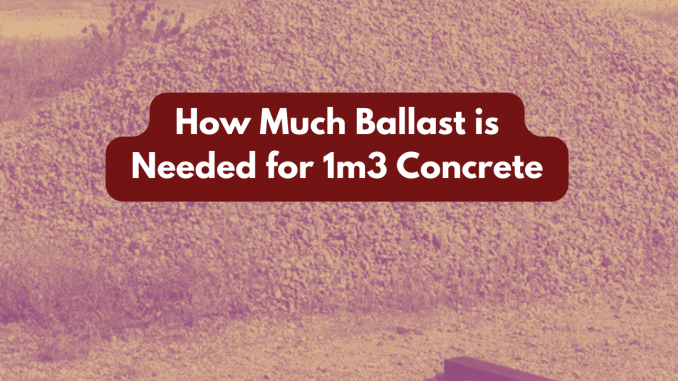
The amount of ballast needed for concrete depends on various factors such as the desired strength, density, and intended use of the concrete mix. Ballast, also known as aggregate, typically consists of coarse materials such as gravel, crushed stone, or sand, and it is used to provide bulk and strength to concrete mixes.
A common proportion for concrete mixtures is 1 part cement, 2 parts sand, and 3 parts aggregate (ballast) by volume. This ratio is often expressed as a mix of “1:2:3”. Therefore, for every cubic metre (1 m^3) of concrete, you would typically need 1/2 cubic metres (or approximately 500 litres) of Ballast, 1/3 cubic metres (approximately 333 litres) of sand and 1/6 cubic metres (167 litres) of cement.
Keep in mind that these ratios can vary depending on the specific requirements of the project, such as the strength, durability, and workability of the concrete. It’s important to consult with a structural engineer or concrete supplier to determine the appropriate mix proportions for your particular application.
How do you Calculate How Much Ballast you Need
The amount of ballast needed for a particular project depends on several factors, including the volume to be filled, the desired density of the ballast material, and any specific requirements for stability or weight distribution. Here’s a general process for calculating how much ballast you need:
- Determine the volume to be filled: Measure the length, width, and height (or depth) of the area where you intend to place the ballast. Multiply these dimensions together to calculate the volume in cubic metres (or cubic feet, depending on your preference).
- Decide on the density of the ballast: The density of the ballast material will affect how much space it occupies and how much weight it provides. Common ballast materials include gravel, crushed stone, or sand, each with its own density. You can typically find the density of the material listed in kilograms per cubic metre (kg/m^3) or pounds per cubic foot (lb/ft^3).
- Calculate the mass or weight of the ballast: Multiply the volume of the area to be filled by the density of the ballast material. This will give you the total mass or weight of the ballast needed in kilograms or pounds.
- Adjust for compaction and settling: Keep in mind that the actual volume of ballast required may be slightly more than the calculated volume due to compaction or settling of the material once it’s in place. You may want to account for this by adding a small percentage (e.g., 5-10%) to your calculated volume.
- Consider any additional factors: Depending on the specific requirements of your project, you may need to adjust the amount of ballast needed. For example, if you’re using ballast in a ship, you’ll need to consider stability requirements and weight distribution. In construction, you may need to account for drainage or structural support needs.
By following these steps and considering the specific requirements of your project, you can calculate how much ballast you need accurately. If you’re unsure about any aspect of the calculation, consulting with a construction engineer or a specialist in the relevant field can be helpful.
When is Ballast Needed?
Ballast as a material typically made of gravel, crushed stone, or sand, which is used to provide stability, support, and weight distribution in applications such as railways, shipbuilding, and construction. It is crucial for ensuring the integrity and longevity of structures, particularly in projects like laying railroad tracks, stabilising ships, and reinforcing concrete. Selecting the right type and amount of ballast is important based on the specific requirements of each project to achieve optimal performance and durability.

Leave a Reply